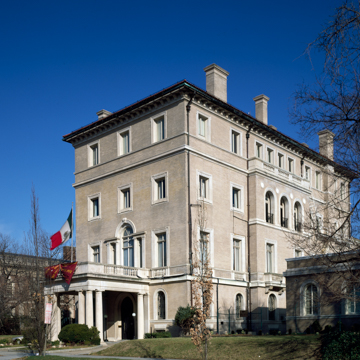Gelasio Caetani, the Italian ambassador in 1924, was a trained architect and engineer and reputedly was involved in the design of the embassy from its site selection to its interior decoration. Caetani and the architects of record, Warren and Wetmore of New York, followed Italian Renaissance models both in the embassy's three-story elevation and in its plan. Proportions and details are more historically correct on this building than on its more eclectic neighbors. As in Italian Renaissance mansions, the ground story is decidedly separated from the piano nobile by a wide belt course. Projection of the bracketed triangular pediments of the main-story windows—based on those of the Palazzo Farnese in Rome—gives sculptural relief to the smooth limestone walls. The two main stories are
You are here
Embassy of Italy
1923–1924, Warren and Wetmore. 2700 16th St. NW
If SAH Archipedia has been useful to you, please consider supporting it.
SAH Archipedia tells the story of the United States through its buildings, landscapes, and cities. This freely available resource empowers the public with authoritative knowledge that deepens their understanding and appreciation of the built environment. But the Society of Architectural Historians, which created SAH Archipedia with University of Virginia Press, needs your support to maintain the high-caliber research, writing, photography, cartography, editing, design, and programming that make SAH Archipedia a trusted online resource available to all who value the history of place, heritage tourism, and learning.














